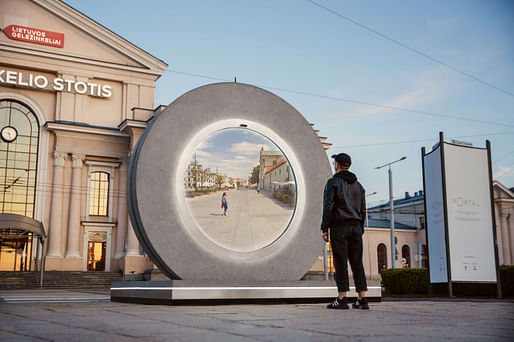

Physical “portals” are up and running, allowing residents of the Lithuanian capital of Vilnius and Lublin, Poland to connect in real-time. The two cities are the first to connect through PORTAL, a non-profit initiative by Go Vilnius, the capital’s development agency. The project aims to construct visual bridges across the world in order to bring people of different cultures together.
The first portals were installed on May 26th, one outside the Vilnius Railway Station and the other 375 miles away in Lublin, Poland. The structures take the shape of circular windows that are equipped with large screens and cameras that broadcast live views between the two cities. According to its organizers, PORTAL is meant to encourage people to rethink the feeling and meaning of unity.
“Humanity is facing a lot of potentially deadly challenges, be it social polarization, climate change, or economic issues,” says Benediktas Gylys, the president of Benediktas Gylys Foundation and the one credited as the initiator of the idea. “Though if we look closely, it’s not a lack of brilliant scientists, activists or leaders, knowledge, or technology that cause these challenges. It’s tribalism, lack of empathy, and a secluded perception of the world, which is often limited to our national borders. That’s why we’ve decided to bring the idea of PORTAL to life – it is a bridge to unity, an invitation to rise above prejudices, above the disagreements that belong to the past, it’s an invitation to rise above the illusion of us and them.”
PORTAL reportedly took five years to develop. The structures were designed by engineers at the Creativity and Innovation Center (LinkMenu fabrikas) at Vilnius Gediminas Technical University. The circular design was chosen because it is an easily recognizable sci-fi symbol for this “visual bridge”. As stated in the project’s press release, it resembles the wheel of time and “...allows a person to ‘travel’ and experience reality on the other side of this ‘bridge’.” Additionally, the developers assert that PORTAL’s form, minimal design, and aesthetics reflect the image of a future city.
These won’t be the only portals. The organizers plan to erect more in other cities in the near future. On the project’s website, the next portals planned are in Reykjavik, the capital of Iceland, and London.
No Comments
Block this user
Are you sure you want to block this user and hide all related comments throughout the site?
Archinect
This is your first comment on Archinect. Your comment will be visible once approved.